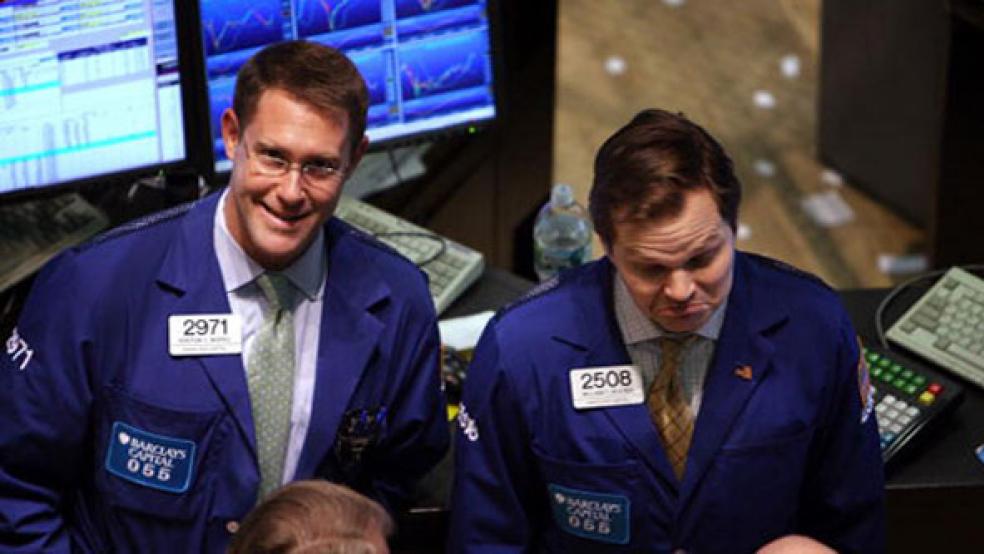Halting a weeklong slide, U.S. stocks regained their footing Friday, ending a volatile trading day up sharply. The Dow Jones Industrial Average rose 125 to 10,193, after briefly dipping below 10,000. The S&P 500 rose 1.5 percent to 1,087 after a mid-session drop that broke below the May 6 low. The tech-heavy Nasdaq rose 24 to 2,229.
In other signs that the recent market plunge may have been overdone, Treasuries erased early gains, signaling a decline in risk-aversion among investors. Copper, which tends to move with expectations of global growth, jumped the most since February. And financial shares in the S&P 500 rose 3.6 percent as a group, as the Senate’s passage of reform legislation removed some of the uncertainty around how financial institutions would be regulated.
After dropping 12 percent from its May 2010 high, is the stock market’s one-day rebound a sign that the worst is over and the bull market is ready to take another leap forward? Or is this just a head fake before the bull market that began in March 2009 turns into a grizzly bear? The drama will play out in the weeks ahead. And it may be a while before we have a clear answer.
The bears move center stage
There are plenty of reasons for investors to be bearish – and for most of last week, they seemed riveted on the negatives. Fed Governor Daniel Tarullo gave voice to investors’ fears of a Greek contagion when he said that the U.S. and global economies could be threatened if the debt crisis curbed lending and global liquidity. Adding fuel to the fire: U.S. unemployment claims jumped by the largest amount in three months, and a controversial financial reform bill was approved by the Senate the day after Tea Party activists made electoral gains by bashing Washington and Wall Street. “We’ve rarely seen a market advance without the participation of financial stocks,” says Greg Valliere, a political and market expert with Potomac Research Group. “Despite the Senate action today, we’ll have several more weeks of uncertainty, and the market does not like uncertainty.”
But the bulls could come back
But today investors seem to have refocused on the positives. After all, the market had been on a tear, up 80 percent in 14 months. That’s farther and faster than the average recovery. Historically, the first correction (a drop of 10 percent or more) in a new bull market comes after the market gains an average of 57 percent over 17 months. So, many analysts thought this one was overdue for a pullback.
But that doesn’t mean we’re headed into a new bear market. “If we assume the bull market ended on April 23rd, it would be one of the weakest and shortest gains in the last 48 years,” Cleve Rueckert, an analyst at the research and money-management firm founded by Laslo Birinyi, wrote in a note to clients today. “A more likely scenario is that the current bull market is experiencing its first official correction.”
The fundamentals look good
While the Greek debt crisis will likely slow European growth – and hurt U.S. companies that are dependent on sales there, the U.S. is a consumer-driven economy, and the consumer has shown signs of life of late. Consumer spending has revived in spite of high unemployment. And consumer prices, which fell in April for the first time in 13 months, could help keep Americans spending. Meanwhile, corporations, which are flush with cash, are beginning to open their wallets again, investing in capital equipment and other companies, and beginning to hire again.
Indeed, we are beginning to see job growth, albeit at a slow pace. Andrew Gledhill, economist at Moody’s Analytics, says it’s not unusual to see spikes in unemployment claims as the economy recovers because more people start looking for work again, but are not yet hired. “This is a transition,” he says, though he expects this job recovery will take longer than is normal at this stage of the recovery because of the depth of the recession. “We don’t have the unemployment rate coming down until 2011, and we don’t think it will get to 5.5 percent until late 2014 or 2015.”
Ironically, Europe’s woes may have had some unintended benefits for the U.S. A flight to safety by global investors, who have rushed into U.S. Treasuries, has sent interest rates on the 10-year Treasury bonds down to 3.22 percent from 3.37 percent Tuesday. Add to that a stronger dollar (which means imports are cheaper for Americans) and a low inflation risk, and the Fed is less likely to raise short-term interest rates anytime soon.
Needed: a mood-altering event
So what could turn investors seriously bullish again? Key will be signs that the Eurozone crisis is not turning into a contagion. Further clarity around the details of financial reform will help. But the best bet in the short term may be the third quarter earnings season, which begins in July. If we see signs that the U.S. economy is continuing to grow in spite of Europe’s woes, investors may find the U.S. market a welcome place again. Quips Valliere: “America may end up the best house in a bad neighborhood.”




